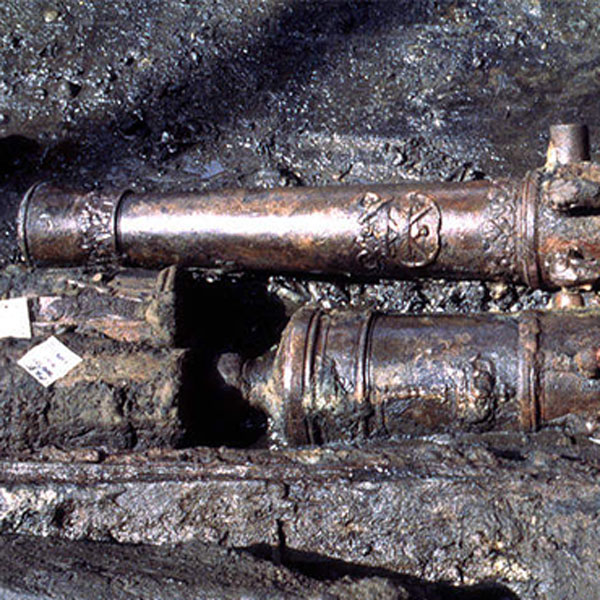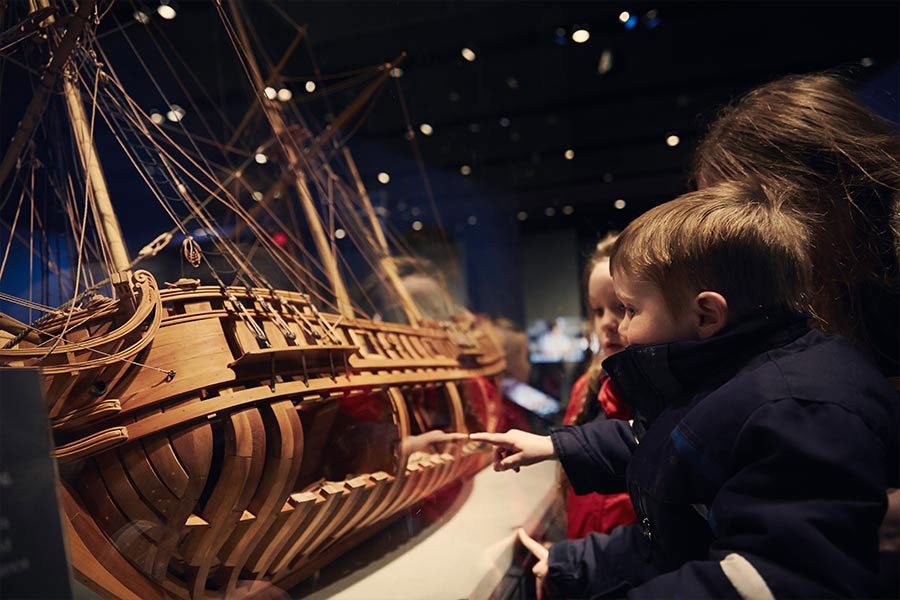Museum sets stage for La Belle exhibition
A 330-year-old Texas story taking shape at the Bullock Museum
SEPTEMBER 19, 2014 (AUSTIN, TX) — One of French explorer Robert Cavelier, sieur de La Salle's ships that landed along the Texas coast nearly 330 years ago will be reassembled in the galleries of the Bullock Texas State History Museum beginning October 25, 2014. Museum staff began setting the stage this month for a dynamic new exhibition centered on the ship that sank in Matagorda Bay in 1686 and was later excavated in the 1990s.
This week marks the arrival at the Bullock Museum of rare artifacts for the upcoming exhibition, "La Belle: The Ship That Changed History," including a 17th-century French Naval ledger on loan from the Archives du Port de Rochefort in France, and the movement of two key ship timbers into place in preparation for this highly anticipated exhibition.
Texas Department of Public Safety officers closed down sections of two Austin streets briefly on Tuesday to allow portions of the historic ship to be moved from storage, around the museum, and into the gallery in preparation for the exhibition. The 800-pound keel and 1,100-pound keelson are the largest portions of what remains of "La Belle." These pieces form the foundation of the bottom third of the ship's hull.
Over the coming weeks, the museum will build the entire show around the ship's keel and keelson. Once the exhibition opens, project conservator Peter Fix of the Texas A&M University Conservation Research Lab will lead a team of experts to rebuild this 600-piece "jigsaw" puzzle, reassembling the hull, timber by timber.
A French Naval ledger from Port De Rochefort, Service historique de la Defense, which is affiliated with the Musée national de la Marine, was among artifacts arriving at the Bullock Museum. The ledger is a 1684 record of "La Belle's" dimensions, and it notes that the ship was loaned to La Salle and eventually lost. The excavated ship and associated artifacts belong to the French government, according to International Maritime Law, but a treaty signed in 2003 says they can stay in Texas unless there is a renegotiation of terms.
More than 125 artifacts will be on display with the ship, and the exhibition will feature newly edited film footage, touch pad activities, and interviews with archaeologists and other experts. Some of the artifacts in "La Belle: The Ship That Changed History" will travel to France in 2016, but most will join the ship to become the centerpiece of a completely renovated first floor of the state's history museum.
A new book about "La Belle" and its associated artifacts is available online and at the museum. "Shipwrecked," a new 4D immersive theater experience premieres Saturday, October 25, 2014 in conjunction with the exhibition. The film follows the perilous journey of the French explorer La Salle, revealing the personalities and struggles that beset both the voyage and colony as told by one of the few survivors, a young boy named Pierre Talon. The 26-minute family film uses 4D effects felt by the audience to create a dynamic experience. For showtimes, museum hours and programs, visit TheStoryofTexas.com.
Downloads
The Bullock Texas State History Museum, a division of the State Preservation Board and an accredited institution of the American Alliance of Museums, creates experiences that educate, engage, and encourage a deeper understanding of Texas. With dynamic, award-winning exhibitions that illuminate Texas history, people, and culture, educational programming for all ages, and an IMAX® theater with a screen the size of Texas, the Museum collaborates with more than 700 museums, libraries, archives, organizations, and individuals across the world to bring the Story of Texas to life. For more information, visit www.TheStoryofTexas.com
Media Contact
| General Inquiries | |
|---|---|
| 512-463-5424 | |

